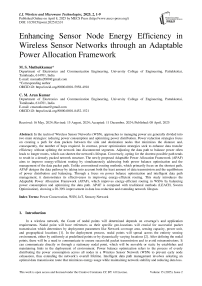Enhancing Sensor Node Energy Efficiency in Wireless Sensor Networks through an Adaptable Power Allocation Framework
Автор: M.S. Muthukkumar, C.M. Arun Kumar
Журнал: International Journal of Wireless and Microwave Technologies @ijwmt
Статья в выпуске: 2 Vol.15, 2025 года.
Бесплатный доступ
In the realm of Wireless Sensor Networks (WSN), approaches to managing power are generally divided into two main strategies: reducing power consumption and optimizing power distribution. Power reduction strategies focus on creating a path for data packets between the sink and destination nodes that minimizes the distance and, consequently, the number of hops required. In contrast, power optimization strategies seek to enhance data transfer efficiency without splitting the network into disconnected segments. Adjusting the data path to balance power often leads to longer routes, which can shorten the network's lifespan. Conversely, opting for the shortest possible path tends to result in a densely packed network structure. The newly proposed Adaptable Power Allocation Framework (APAF) aims to improve energy-efficient routing by simultaneously addressing both power balance optimization and the management of the data packet path. Unlike conventional routing methods, which primarily focus on the shortest path, APAF designs the data pathway by taking into account both the least amount of data transmission and the equilibrium of power distribution and balancing. Through a focus on power balance optimization and intelligent data path management, it demonstrates its effectiveness in improving energy-efficient routing. This study introduces the Adaptable Power Allocation Framework (APAF), which improves energy-efficient routing in WSNs by balancing power consumption and optimizing the data path. APAF is compared with traditional methods (LEACH, Swarm Optimization), showing a 20-30% improvement in data loss reduction and extending network lifespan.
Power Conservation, WSN, IoT, Sensory Network
Короткий адрес: https://sciup.org/15019838
IDR: 15019838 | DOI: 10.5815/ijwmt.2025.02.01


